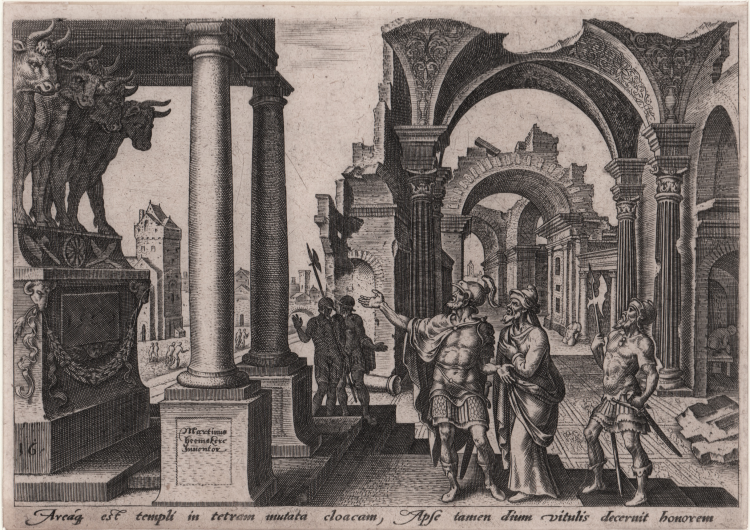



| Reference: | S35322 |
| Author | Philippe GALLE |
| Year: | 1569 |
| Measures: | 205 x 145 mm |


| Reference: | S35322 |
| Author | Philippe GALLE |
| Year: | 1569 |
| Measures: | 205 x 145 mm |
Engraving, 1569, from The Disasters of The Jewish People series of prints by Philip Galle and Maerten van Heemskerck.
A fine impression, printed on contemporary laid paper, with thin margins, very good condition.
Maerten van Heemskerck’s series of prints entitled Clades Judææ Gentis – or The Disasters of the Jewish People – contains backdrops that are teeming with architectural discord. Designed by Heemskerck in the late 1560s and engraved by Philips Galle, the series contains twenty-two prints. It begins with a self-portrait frontispiece, and ends with the so-called “final destruction” of Titus Sacking Jerusalem. In between, selected moments in Jewish history appear. Throughout the series, there is an emphasis on themes of idol worship and temple destruction. Other themes include nations divided, and the Jewish refusal to recognize Christ as the fulfillment of the scriptures. Heemskerck has designed them to emphasize his own vast knowledge of ancient Roman ruins. This is true of nearly every print in the series. Heemskerck either shows us vivid images of ruination in process or, its aftermath.
The first edition, dated 1569, is printed by the same engraver Philips Galle (Haarlem). There are, however, four other editions of the series: three edited in Antwerp by Carel Collaert, Theodoor Galle and Johannes Galle, and one unaddressed.
Bibliografia
Arthur J. Di Furia, Self-Fashioning and Ruination in a Print Series by Maerten van Heemskerck, in M. Galassi - A. De Floriani, “Culture figurative a confronto tra Fiandre e Italia dal XV al XVII secolo, Atti del convegno internazionale Nord/Sud. Ricezioni Fiamminghe al di qua delle Alpi. Prospettive di studio e indagini tecniche”, Cinisello Balsamo, 2008, pp. 117 – 125. New Hollstein I.199.237.i/iii; New Hollstein (P.Galle) I.151-179.i/iii; Hollstein VII.74.12-32.i/iii; Hollstein VIII.242.202-223; Bartsch LVI.153.052:1-22
Philippe GALLE (Haarlem, 1537; Anversa, 12 o 29 Marzo 1612)
|
Draughtsman, engraver, publisher, print dealer, writer and historian. It is possible that he was a pupil in Haarlem of Dirk Volkertsz. Coornhert, but more than likely he was trained in the Antwerp workshop of Hieronymous Cock, who published Galle’s first prints in 1557 and for whom he worked for many years. Shortly after 1557 Philip Galle started his own publishing and print business, for which he travelled extensively: in 1560–61 he visited the southern Netherlands, France, Germany and Italy. After 1564 he settled in Antwerp, where he acquired citizenship in 1571, the same year in which he became a master in the city’s Guild of St Luke. He served as dean of the guild from 1585 to 1587. His documented pupils were H. van Doort in 1580, Karel van Mallery (1571–1635) in 1586, Jean-Baptiste Barbé (1578–1649) in 1594 and Peter Backereel (d 1637) in 1605. Others working at the workshop and publishing house included Philip’s sons Theodor and Cornelis, his son-in-law Adriaen Collaert, pupils van Mallery and Barbé, the Wierix brothers, Hendrick Goltzius, Crispijn de Passe I and other members of the Collaert family.
|
Philippe GALLE (Haarlem, 1537; Anversa, 12 o 29 Marzo 1612)
|
Draughtsman, engraver, publisher, print dealer, writer and historian. It is possible that he was a pupil in Haarlem of Dirk Volkertsz. Coornhert, but more than likely he was trained in the Antwerp workshop of Hieronymous Cock, who published Galle’s first prints in 1557 and for whom he worked for many years. Shortly after 1557 Philip Galle started his own publishing and print business, for which he travelled extensively: in 1560–61 he visited the southern Netherlands, France, Germany and Italy. After 1564 he settled in Antwerp, where he acquired citizenship in 1571, the same year in which he became a master in the city’s Guild of St Luke. He served as dean of the guild from 1585 to 1587. His documented pupils were H. van Doort in 1580, Karel van Mallery (1571–1635) in 1586, Jean-Baptiste Barbé (1578–1649) in 1594 and Peter Backereel (d 1637) in 1605. Others working at the workshop and publishing house included Philip’s sons Theodor and Cornelis, his son-in-law Adriaen Collaert, pupils van Mallery and Barbé, the Wierix brothers, Hendrick Goltzius, Crispijn de Passe I and other members of the Collaert family.
|